NORTH WALES COAST RAILWAY:NOTICE BOARD
Rheilffordd arfordir gogledd Cymru: Hysbysfwrdd
17 August 2020





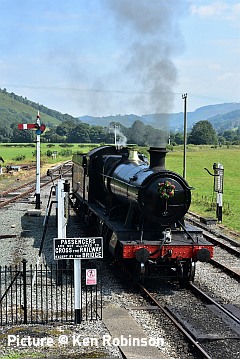
Forthcoming events
(see also our Calendar page for venues)
Note: we have removed all entries relating to meetings as the events are cancelled.
The Clwyd Railway Circle has informed us that all their dates for the 2020=21 season, previously listed here, have now been suspended.
September 2020
Saturday 5 September Steam at Chester 'The Cheshireman' (Railway Touring Company). Norwich to Chester. Loco 6233 for part of the journey.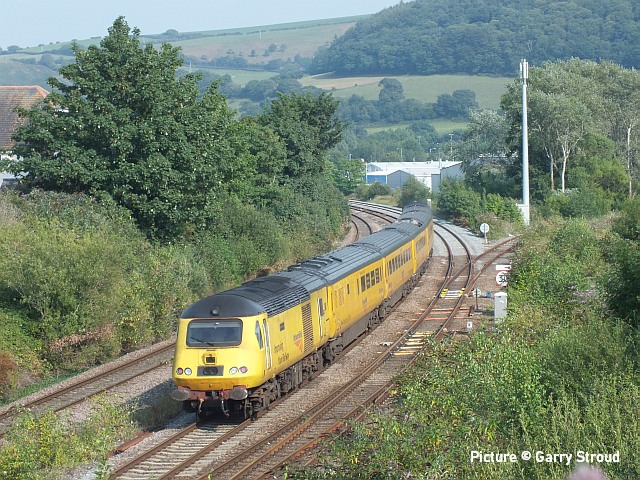
The New Measurement Train approaching Llandudno Junction, 13 August. Picture by Garry Stroud.
Flask visitor
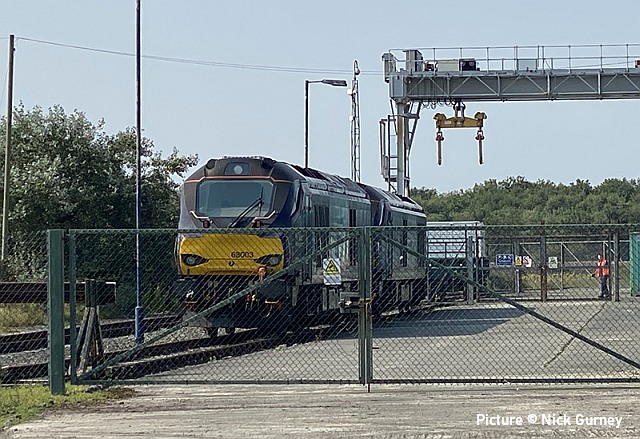
On 13 August DRS ran one of its occasional flask trains, intended to retain experience of the line and equipment even though Wylfa power station is now closed. The locos this time were 68 003 Astute and 68 001 Evolution, seen above in the loading area (Nick Gurney).
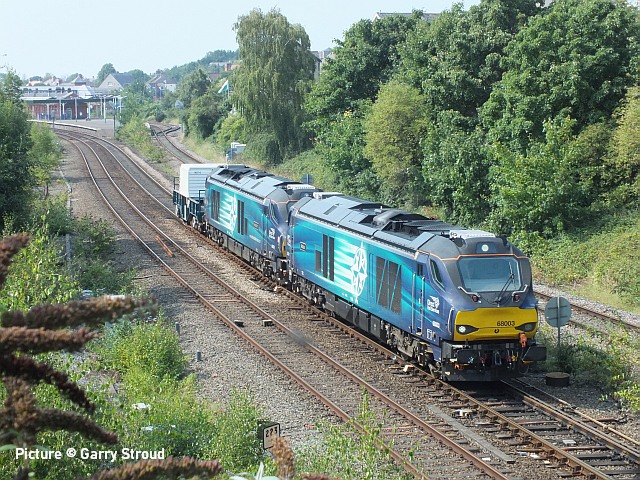
Passing Llandudno Junction (Garry Stroud).
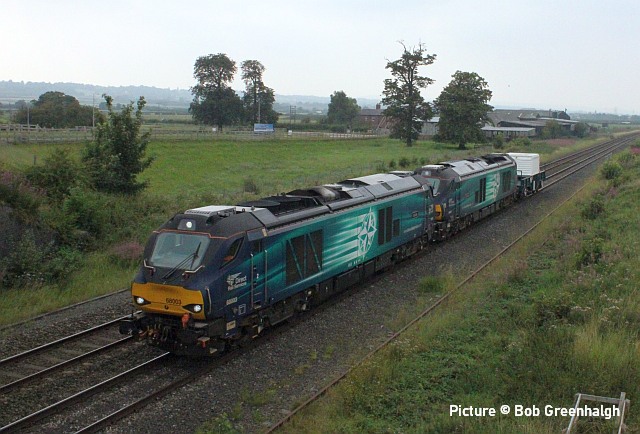
Beeches Farm (Bob Greenhalgh).
70 on the branch
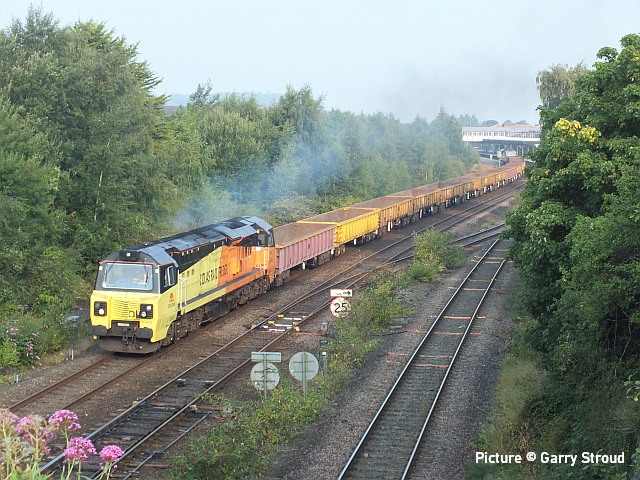
70 809 and 70 805 visited the Blaenau Ffestiniog branch with a spoil removal train, 05:12 from Crewe Basford Hall to the engineering works on the branch, 12 August. Above, arriving at Llandudno Junction...
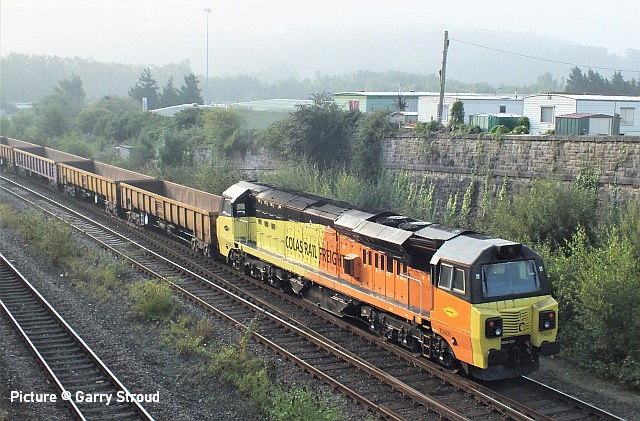
... and departing at 07:45, with 70 805 now at the rear heading for the Conwy Valley.
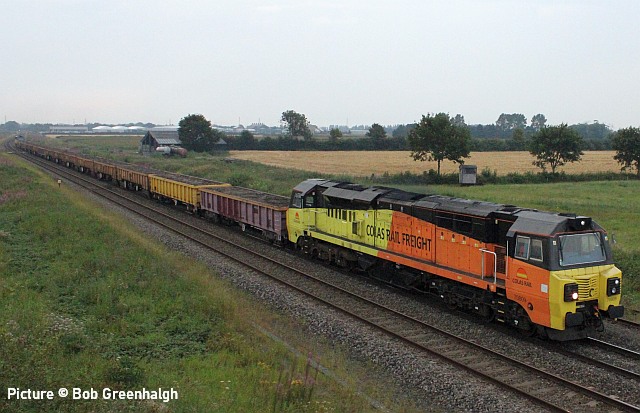
The loaded train passes Beeches Farm just before the rain started (Bob Greenhalgh).
Trials and Testing - by John Cowlishaw
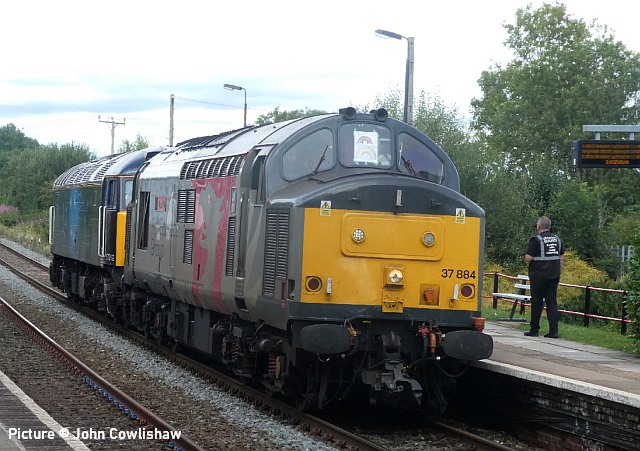
On 7 August 37 884 Cepheus ...
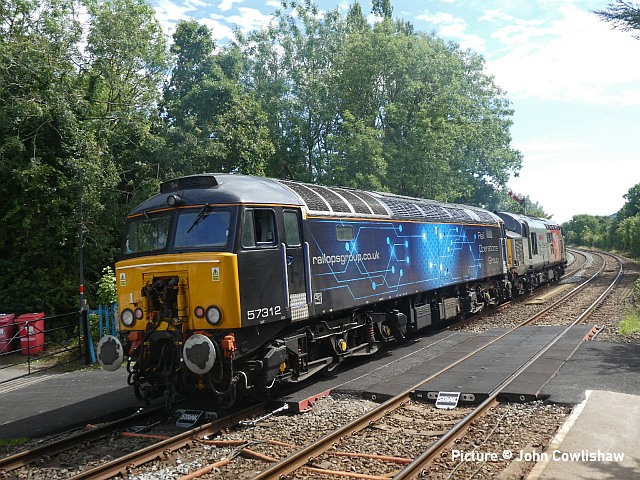
... and 57 312, both operated by Rail Operations Group, made a trial run to Birkenhead North EMU Depot and they were seen on the return trip at Penyffordd where they had to await the service train to clear the block. Also noteworthy is one of the two TfW security team on the station (outnumbering the passengers) who were most friendly to the photographers (also outnumbering the passengers). The station was also being repainted in TfW black and red (again outnumbering the passengers!). The reason for this is probably the ongoing delivery of the new Merseyrail units, and the disposal of the old ones.
Careful note of the screen would show two cancellations; one diagram was taken out due to a 'crew shortage' but there was rumour that the crew were re-deployed on to the coast which was reportedly very busy on the Friday afternoon.
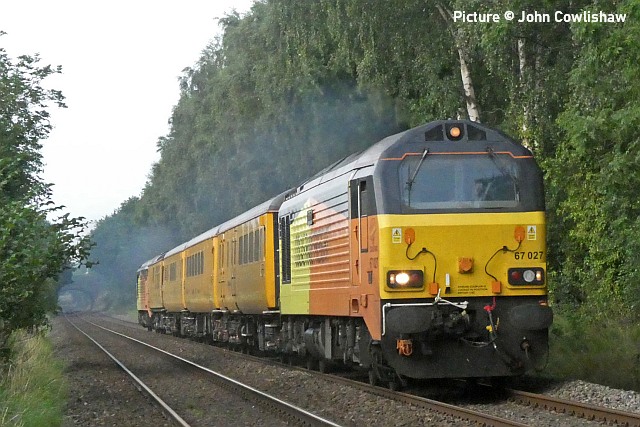
Network Rail runs two test trains to Wrexham. One from the north goes to Wrexham, then Bidston, and Wrexham Central before returning northwards, generally on a Monday. The other from the south runs on Friday and comes to Wrexham General, reverses and then heads back south. On 14 August 67 027 Charlotte (above) ...
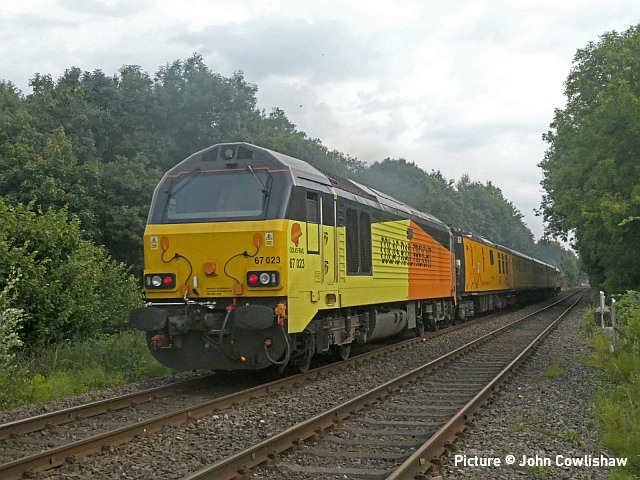
... and 67 023 Stella and provided the motive power for the latter. The train was delayed arriving in Wrexham as the northbound service train was late and so it had to await the 16:51 Holyhead-Shrewsbury to clear the block to Gobowen before making its return journey. It is seen passing the public footpath at Rhostyllen, north of the former Bersham colliery.
Chirk and Gobowen - by Chris Morrison
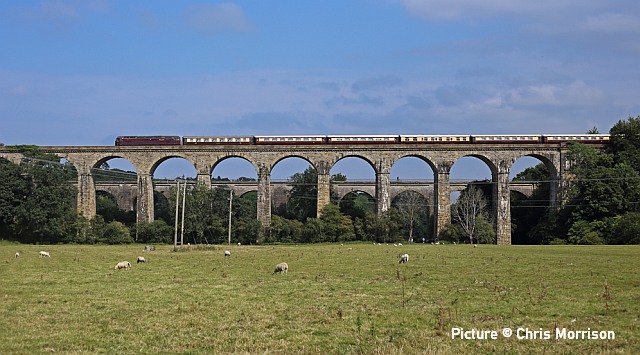
West Coast Railways 57 316 heading the 12:07 Coventry-Chester 'Northern Belle' passes over Henry Robertson's Chirk Viaduct of 1848 with Thomas Telford's canal aqueduct of 1801 behind. 15 August.
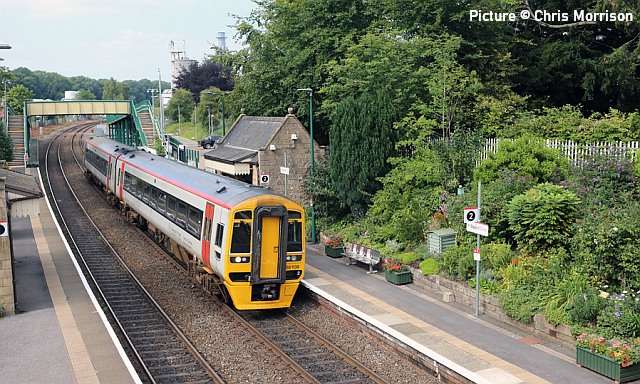
Transport for Wales 158 838 arrives at Chirk station with the 13:28 Holyhead-Birmingham-International on 15 August. The well tended gardens here are a credit to the station adopters.
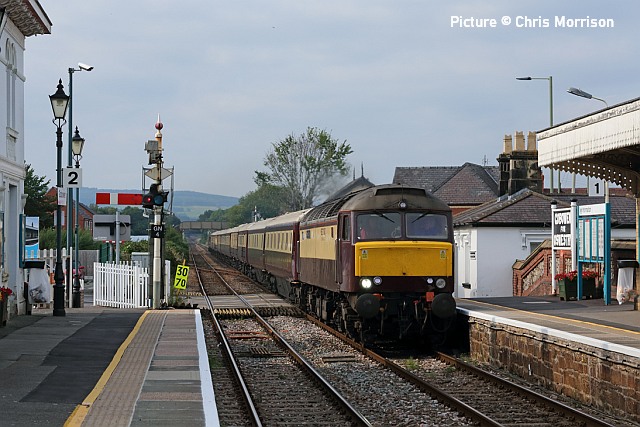
West Coast Railways 57 601 heads the 14:49 Chester-Birmingham International 'Northern Belle' through Gobowen. Both outward and return trains were about an hour late due to the stock being delayed at Stafford on the way from Carnforth to Coventry.
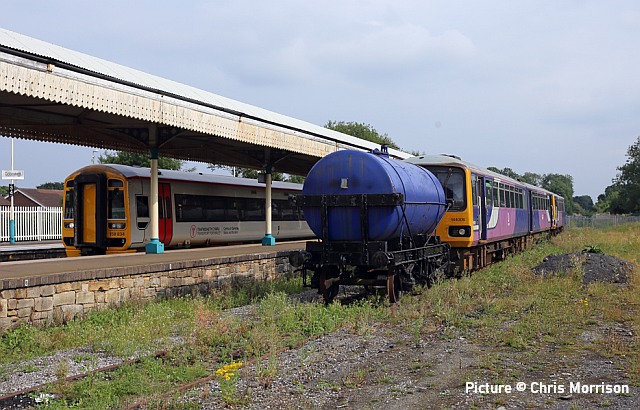
Transport for Wales 158 834 arrives at Gobowen with the 15:10 Birmingham International- Holyhead past Cambrian Railways 144 006 and 144 007 which are still in the yard. 15 August.
Second 230 arrives
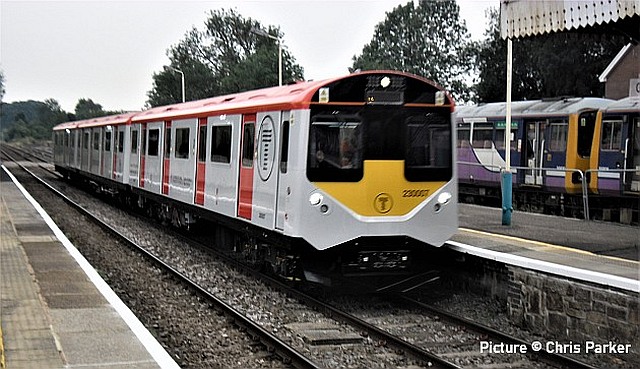
The second of the five TfW Class 230s made its way from Long Marston to Wrexham on 13 August. Chris Parker was at Gobowen to see it.
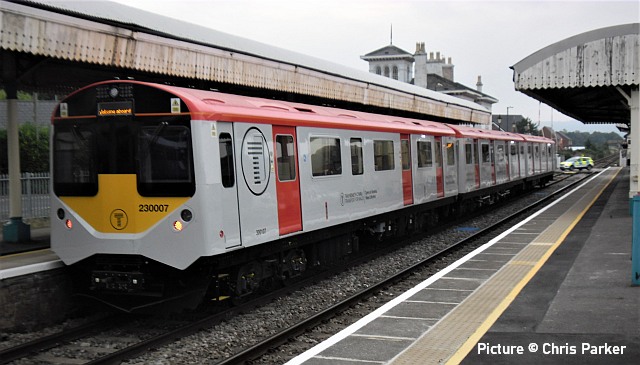
Chris writes: 'The car park at Gobowen was the busiest I've seen it since before lockdown even though it's the latest I've been there. About 10 people alighted from a southbound service train which called while I was waiting. Still no sign of the booking office / waiting room / café reopening though.'
Class 230: how it works
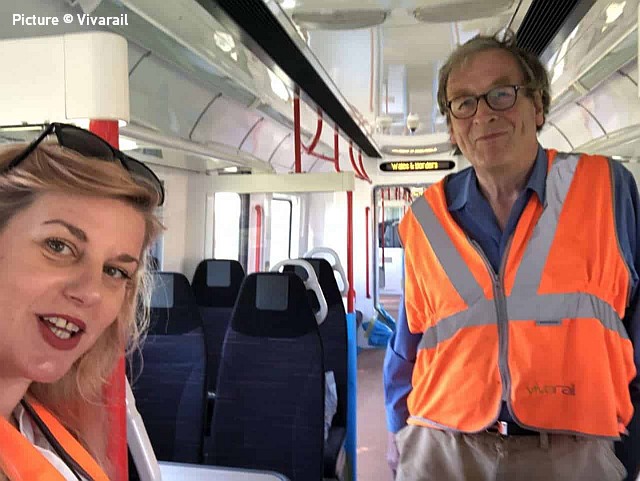
The gentleman above is Adrian Shooter CBE, the Chairman of Vivarail, who conceived the idea for the 230 after retiring as Chairman of Chiltern Railways.
Thanks to everyone who responded to our query about the technicalities of the Transport for Wales Class 230 trains. These trains, which re created from redundant London Underground 'D78' stock formerly used on the District Line, a 'sub-surface' line which can fit rolling stock of main line dimensions - indeed at one time through trains ran there from the LNWR's London network.
The 'new' D-trains retain the body (with some modifications and a new interior), bogies and electric traction motors. They are available from the Vivarail company in various configurations including diesel-electric with a diesel engines driving a generator generating power for the motors; battery power with static charging points at termini; or 'hybrid' which is the option chosen by Transport for Wales. Interiors and door layouts are as requite by the customer.
In three-car set, each end (driving) coach has two 'rafts' of batteries between the bogies which supply power to the motors. Under the un-powered centre coach are four 200 HP 'Gensets' each comprising a Ford 'Duratorq' 3.2 Litre engine driving a generator, in a module which can be quickly removed for maintenance. Automatic systems detect when the batteries need charging and run the diesel engines only as necessary. An added refinement is a GPS-based 'geo-fencing' system which can be programmed to inhibit the operation of the engines in stations and 'sensitive areas.' Also present is a 'regenerative braking' feature which allows the train's motors to work as generators to charge the batteries, absorbing energy when braking is required, although tradtional wheel brakes are still needed when speed becomes low.
With 800 HP theoretically available 'on tap' per train, and lightweight bodies, some speedy acceleration and hill-climbing should be within the train's capacity, despite the weight of the engines and batteries. This is borne out by observations on the Borderlands line during the testing phase, although in service a full load of passengers will make some difference.
Speed is limited to 60 mph, which will be no problem on the Borderlands line, but the tight non-stop timings of Chester - Crewe shuttles will need to make the most of the acceleration capabilities. It's not certain whether the Crewe service will be involved in any case, as an enhanced half-hourly Borderlands timetable will require four of the five. The Conwy Valley line, mentioned in early publicity, will no longer be involved.
Sources: Vivarail 'First trip on 230 006'. Rail Insider, September 2019. Emails from readers.
Class 44 : a request - by Steve Morris
On January 21st 1978 diesel loco 44 008 worked a "Farewell Class 44" Railtour which for part of the itinerary ran between Chester and Shrewsbury. I am looking for a
decent quality image of it working this train for possible inclusion in a book I am producing. However, the image needs to have been taken whilst it was in Wales. This means the section of line between Rossett Junction and Chirk. This includes Wrexham so I was hoping somebody may have photographed it in that area. As far as I know this was the only time a class 44 worked in Wales, unless anybody can tell me otherwise of course ...
[If you can help, contact this website and we will pass on your details.]
Birkenhead feedback
David Pool's article about the Birkenhead area in the last issue generated some correspondence, and has been edited accordingly. To clarify: The Stephenson Locomotive Society trains ran from/to Birmingham, not Paddington. For those who wanted to avail themselves of another steam run both trains ran to and from Chester one of which had 9F haulage. Thanks to Richard Neale for setting us right on this.
The steam train seen in Woodside station was probably the daily parcels service, as steam passenger services had definitely ceased by then.
Regarding the 1988 'Vintage Rail and Public Transport Weekend' , Chris Magner writes: 'Whilst the Wirral Transport Users/ Association gave great support, Lever Brothers, Port Sunlight were the main sponsors of the event, celebrating the centenary. Port Sunlight Centenary Weekend. It was Levers who paid all the bills including transport costs for the BR coaches, hire of the steam locos, building the special platform etc all of which were beyond the financial clout of the WTUA. Angus Tilston from Levers masterminded the whole events of that memorable weekend. It was the last steam working on the Wirral.'
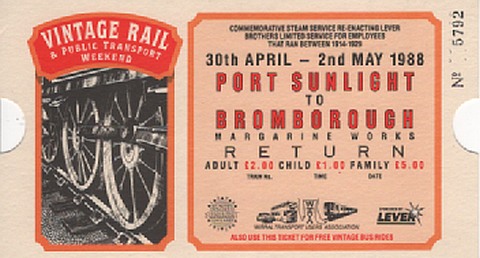
Oliver Hambly, of the Transport Past Times collector's website writes to say that he has for sale a ticket for the event. See 'latest products' on the home page.
Llangollen Railway scenes
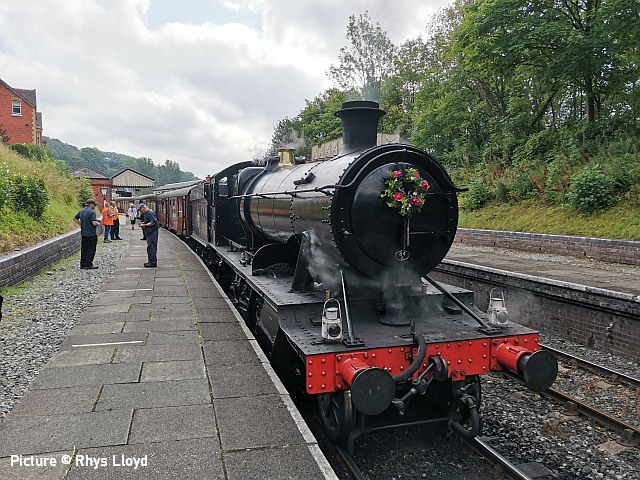
Saturday 15 August at Llangollen/ Duty steam loco 3802 carries a wreath out of respect for the and the train crew and passenger who lost their lives in the tragic Stonehaven accident. Picture by Rhys Lloyd.
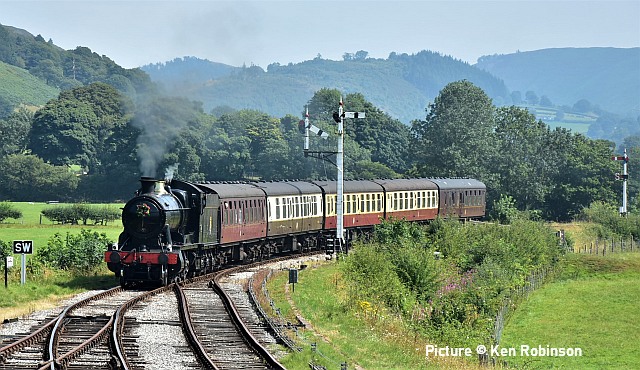
Arriving at Carrog (Ken Robinson).
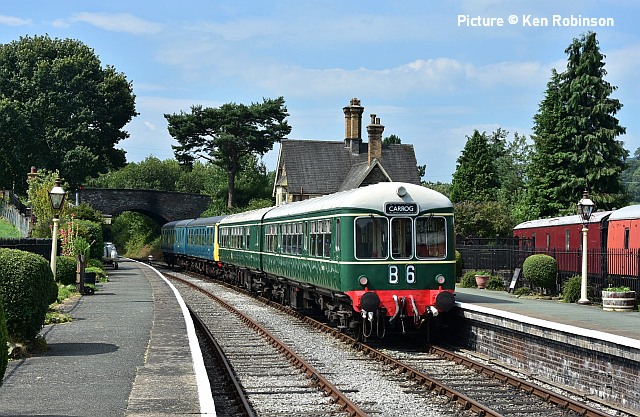
The class 109 'Wickham' unit and the class 104 behind, ready to depart with the 12:20 back to Llangollen (Ken Robinson).
Looking back: Widnes - with David Pool
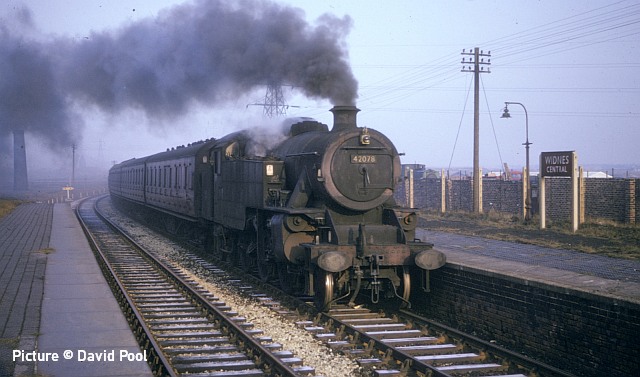
The history of the stations in Widnes is somewhat complex. The present Widnes Station was previously Farnworth, or Widnes North, and two other stations Widnes Central and Widnes South were closed in the 1960s. On 2 April 1964 a Fairburn Tank 42078 was entering Widnes Central with the 07:35 Liverpool Central to Warrington Central. This was on the loop line, branching off the direct Liverpool Central to Manchester Central line at Hough Green to reach Widnes Central and Tanhouse Lane stations, and closed in October 1964. Passenger services on the loop line had been reduced to peak hours only.
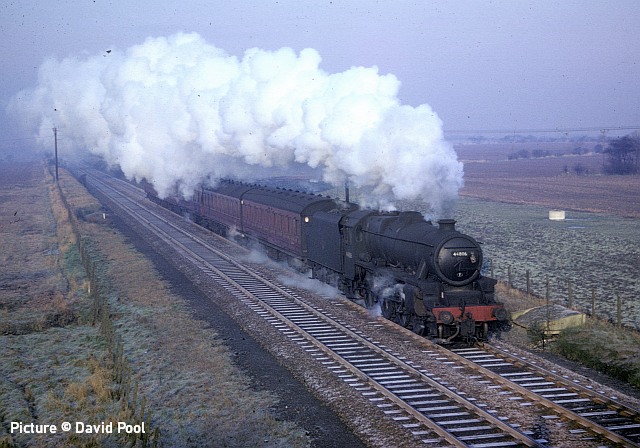
On the direct line between Hough Green and Farnworth a Class 5 44806 was heading the 07:46 Liverpool Central to Manchester Central on 4 April 1966. The sun had not yet melted the frost from what had been a very cold night. This particular locomotive has been saved, at first displayed in the Manchester Science and Industry Museum, then subsequently operating on various preserved railways.
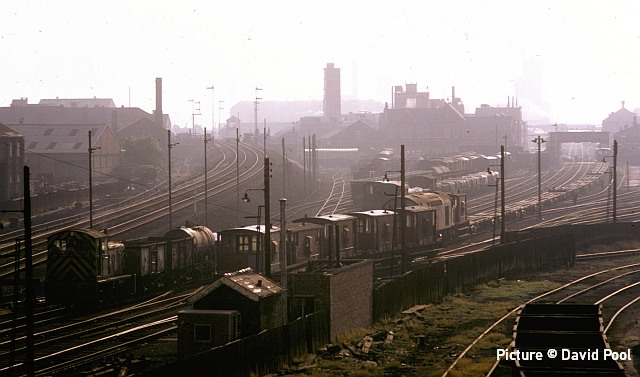
The view into the sun would not be my preferred choice for a photograph, but I couldn’t resist a shot of the main sidings at Widnes on 13 August 1968. The twin tracks on the left hand side are the present route between Ditton Junction and Warrington Arpley via Fiddlers Ferry. Widnes South station would have been on this line. The right hand twin track passing under a footbridge at a level crossing is the original line to Fiddlers Ferry, joining the other line at Carterhouse Junction. I was not able to note the numbers of the 03 and the 40 visible in the scene, which gives an indication of the extent of rail traffic which Widnes had once enjoyed.
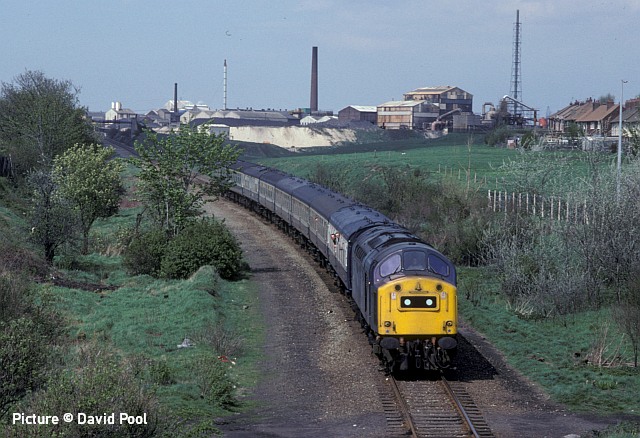
This is a particularly unusual photo, in that it shows a passenger train near Appleton on the line between St Helens and Widnes (originally the St Helens and Runcorn Gap Railway) on Sunday 13 May 1979. Passenger services had been withdrawn in 1951, but there were a few freight workings each weekday. On this occasion the 1315 from Manchester Victoria to Liverpool Lime Street had been diverted, and 40 195 is heading towards Widnes. It would be interesting to discover how it had reached St Helens, since a double reversal at St Helens Junction was unlikely.
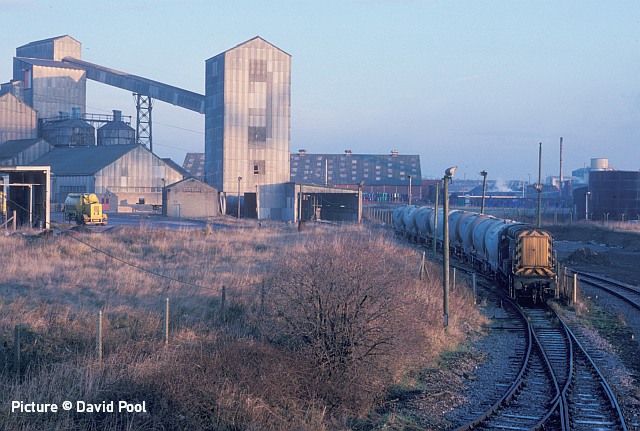
The Blue Circle Cement Works at Tanhouse Lane had a rail connection to the line from Carterhouse Junction, and cement wagons were conveyed to the main line at Ditton Junction. On 20 January 1989 the motive power was 08 703, and the early morning sun provided just enough light for a nice shot as the train was preparing to leave.
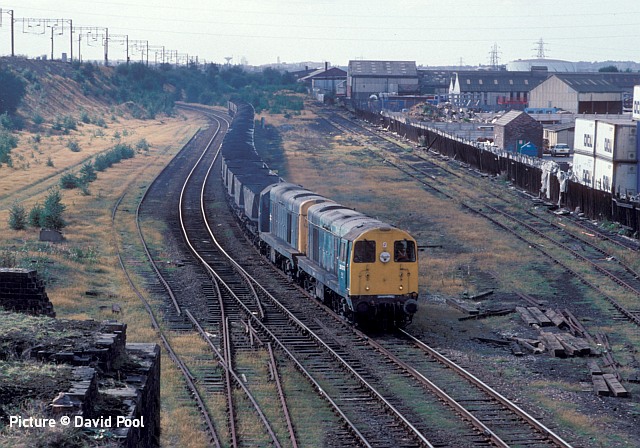
The line between Widnes and Ditton Junction passes under the main Liverpool to Runcorn line before reaching the Junction. A pair of Class 20s, 20 197 and 20 073, are coming from the Junction towards Fiddlers Ferry with MGR coal wagons.
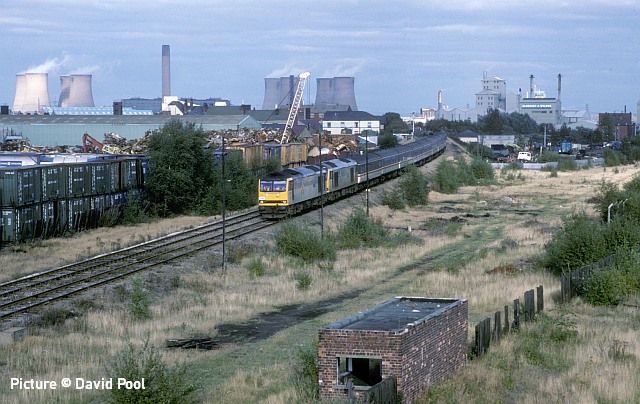
In the opposite direction, a Pathfinder Railtour on 17 September 1994 had come from the Fiddlers Ferry direction and is passing the site of the sidings photographed in 1968. 60 085 and 60 082 are on the leg between Latchford sidings and Lime Street on day one of “The Lancastrians”, from Crewe to Blackpool.
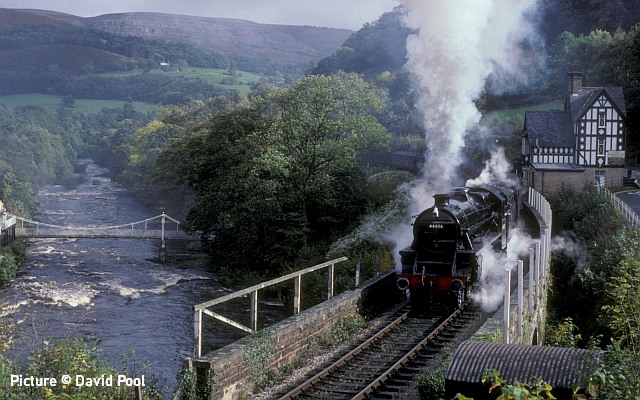
The Class 5 44806 which I photographed at Widnes in 1966 has had a remarkable existence since then! On 17 October 1998 it was on the Llangollen Railway, and is providing the classic shot of Berwyn Station and the Chain Bridge over the River Dee.
Cambrian Corner: Doing the Barmouth Walk - with Tim Rogers
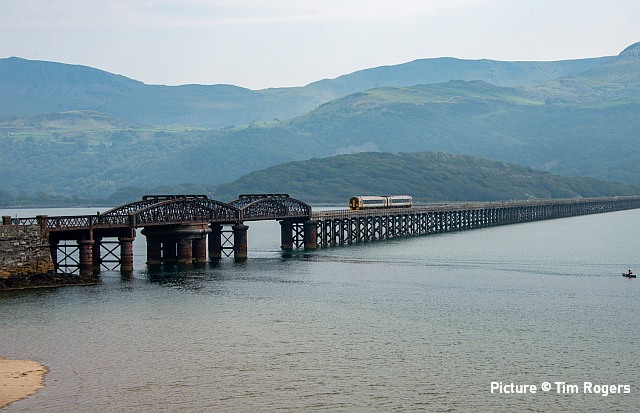
The walk across Barmouth bridge is one of the highlights of the town: Tim made the pilgrimage on 12 August, and took these photographs. Above, 158 836 crosses the bridge working 2J11 10:09 Birmingham International to Pwllheli...
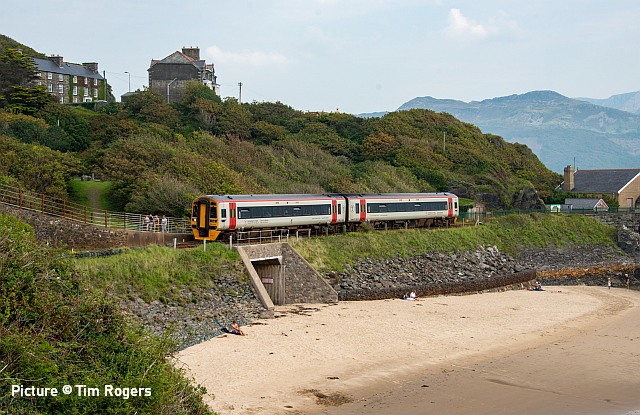
... passes the old toll cottage and crosses the bridge which has been proposed as part of a new pedestrian and cycle route from the bridge to the town avoiding the dangerous road ...
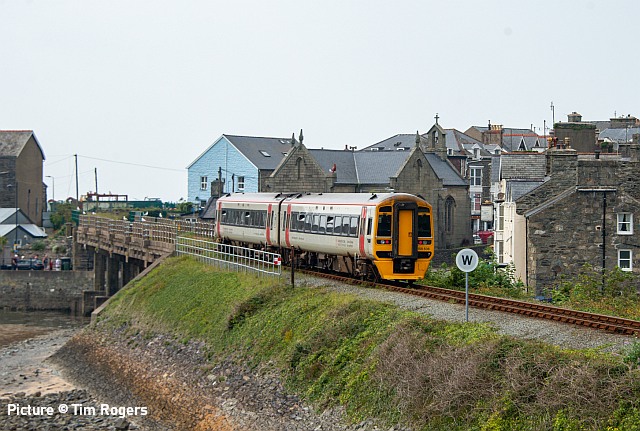
... and on towards the station. Re-liverying of the 158s seems to be proceeding apace.
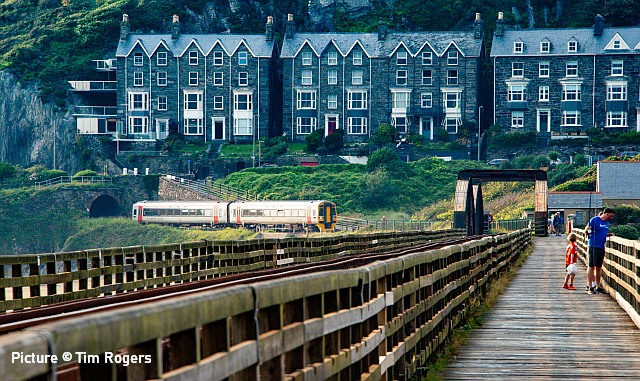
Seen from the bridge footway, 158 818 approaches with 2G75 17:42 Pwllheli to Machynlleth
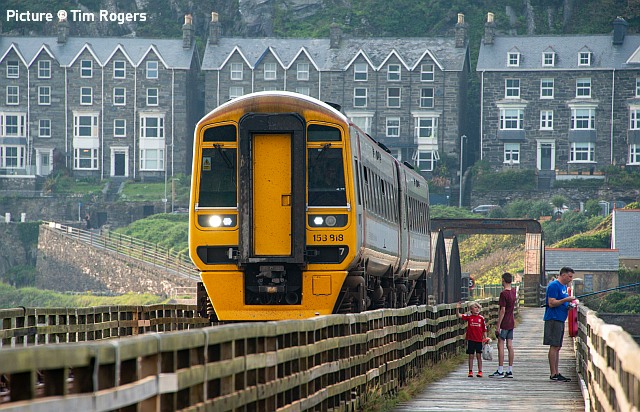
... and rumbles slowly past the angers and walkers.
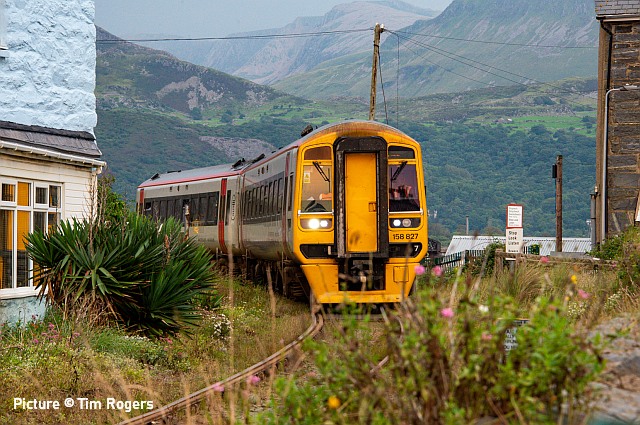
158 827 in exotic-looking surroundings is working 2J23 16:10 Birmingham International to Pwllheli.
The line to Barmouth will be closed for several weeks each autumn for the next three years, while the bridge is being refurbished. The first period starts after the last train on 16 October and ends on 2 November; the next two will be long three-month closures.
From Dave Sallery's Archive
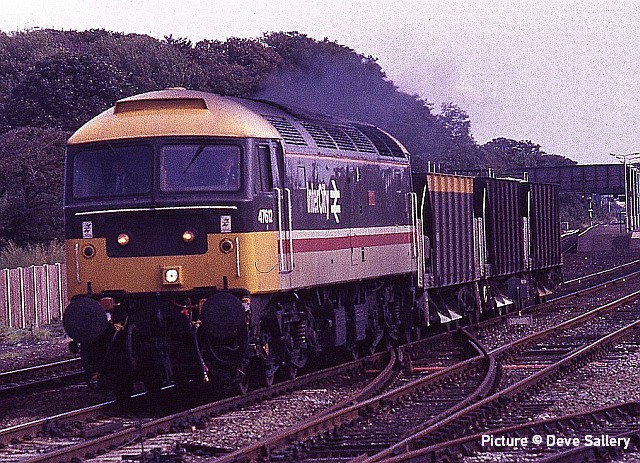
In 'InterCity' livery on 16 September 1987, 47 612 Titan passes Sandy Lane crossing, Prestatyn with a short train of bogie ballast hoppers for Penmaenmawr. In it's life from 1965 to 2005 this loco carried numbers D1665, 47 080, 47 612, 47 838, 47 612 (again), and 47 779. It's good that we have the Class 47 website to keep track of such things.
The Western Region re-used several names from ancient broad-gauge locos, in this case a South Devon Railway 'Gorgon' class 4-4-0ST built in 1866.
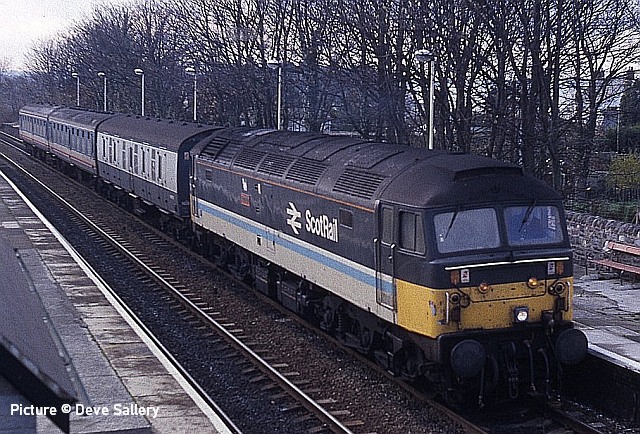
On 21 November 1990 Scotrail push-pull loco 47 704 Dunedin, during a short period of allocation to Crewe diesel depot, found itself working with a 'scratch set' of coaches on a local service from from Holyhead to Llandudno, seen at Llanfairfechan. This service was normally worked by a Regional Railways Class 101 DMU but by this date the survivors often suffered problems, but the railway staff of the day found ways to carry on. But did the loco actually run round its short train at Llandudno Junction to serve Llandudno? In later years 47 704 worked for the 'Fragonset' (later FM Rail) company, finally being scrapped in 2006 after that organisation went out of business.
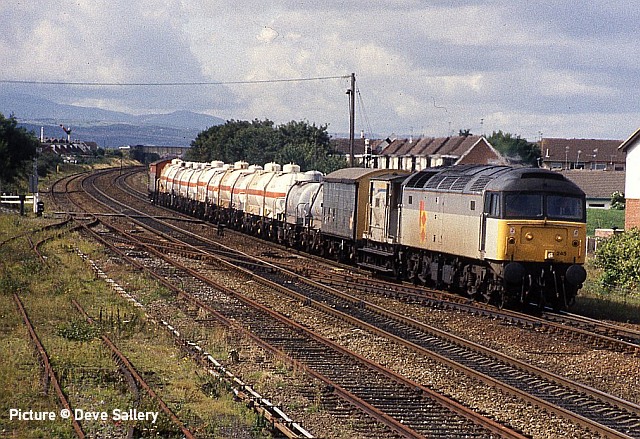
47 245 passing Prestatyn box on 31 August 1992. Amlwch (Octel) - Ellesmere Port service. These tanks carried bromine products extracted from seawater; there is an excellent website detailing the life and times of the Associated Octel plant. 47 245 survives today in the West Coast Railways fleet.
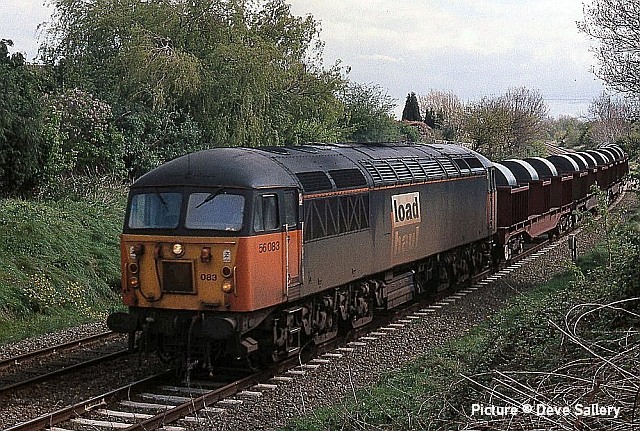
On 24 April 1998, 56 083 rumbling down the gradient near Aston, between Hawarden and Shotton with a load of steel coils for treatment at the Shotton works.
See Dave Sallery's Flickr site for many more images.
Bala Lake scenes - by Jim Ikin
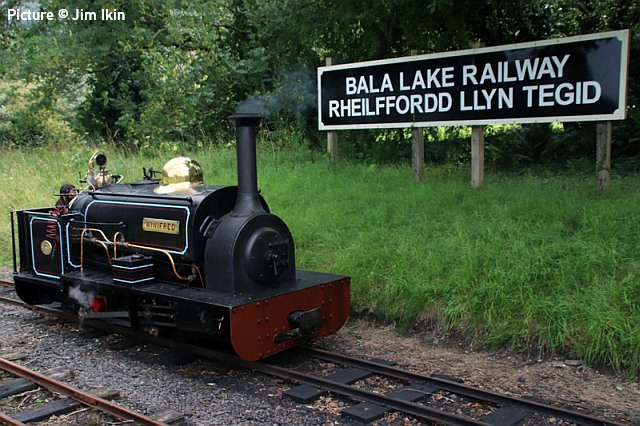
Winifred was undertaking the Bala Lake Railway service on 14 August. Trains are running every day in August and most days in September.
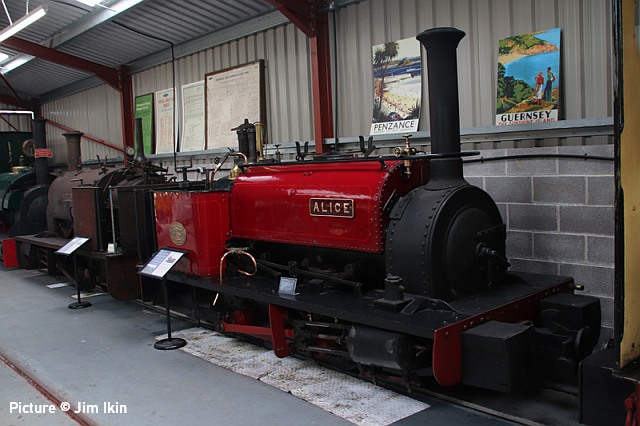
Loco Holy War is being worked on at present, and next in line for attention is Alice seen in the Heritage Centre.
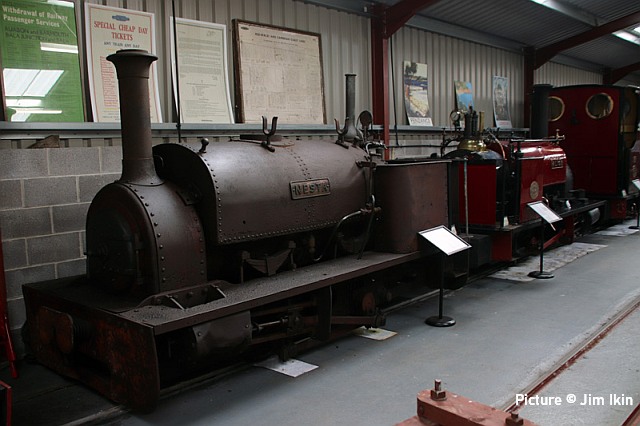
On loan to the BLR from Mr Robert Gambrill, ex-Penrhyn quarries Hunslet Nesta, works number 704, was found in a swamp in Puerto Rico – witness the holes in the saddle tank.
North Wales Coast home page | Archive | Previous Notice Board